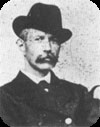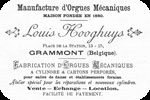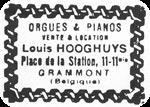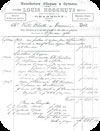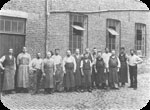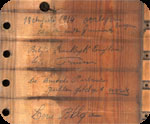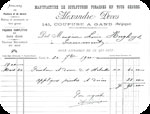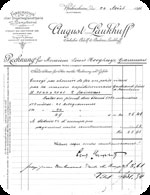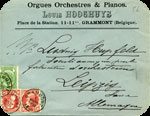 |
| Home
History |
| Part 2: from church to barrel organ | |
On
14 May 1856, the most famous member of the Hooghuys family was
born: Louis François Hooghuys. Although he was a good craftsman
concerning church organs (he learned a good deal from his father
and he also worked for some time in the Anneessens firm at Geraardsbergen),
he decided to switch to the building of mechanical barrel organs.
So, in 1880, the Manufacture d'orgues mécaniques Louis Hooghuys
was established: it was one of the oldest firms in this field in
Belgium! At first, Louis François hired a workplace in the Mill
Street in Geraardsbergen but eventually, in 1882, he moved to the
Place de la Station in the same city. |
|
The
workmen were treated in a – for that time – very human way, as
you can judge from the work
regulations (.pdf, 134kb): for example,
the working hours were very flexible. During it's most active period, the firm counted about 15 working people. Unfortunately, a lot of valuable factory documents have been lost, due to the fact that German soldiers were billeted in the building during the first World War (this loss makes it hard to say how many instruments Louis François Hooghuys built exactly). Remarkable in any way is that a lot of people who started building music instruments in the region of Geraardsbergen, made their first steps in the Hooghuys factory, such as Theodorus Bruylandt, who – afterwards – sold barrel piano's. Furthermore, several family members worked in the factory: Edgard Georges (Louis' brother), who pinned barrels and arranged organ books; also two other brothers of Louis: François Louis (1858-?) was responsible for the pipework while Edouard Joseph (1862-1925) was involved with the pneumatic parts of the organs. Victor Valère (1904-1978) – son of Edgard Georges – also worked in the firm for some time as a book puncher. |
Initially,
the company only built barrel organs; however, large examples haven't
been preserved save on pictures. The first book organ was delivered
in about 1900, and it was quite special, because it was rebuilt
from barrel to book mechanism, while it retained the possibility
to play barrels (by means of a double mechanism). From that moment,
the Hooghuys firm built several types of organs: small and ‘normal'
fair organs as well as dance organs. Not only did Hooghuys make
new instruments, he also repaired and restored organs from other
builders (Bruder, Gavioli, …); judging from factory ledgers, these
activitities seem to have been a bigger source of income than new
organs.
Compared to other organ builders, like Mortier, Hooghuys built relatively few instruments. The construction of a new instrument was only started after careful consultation of the client and his wishes; moreover, also Louis Hooghuys' benevolence played a role: he didn't want to build just anything! Clients always had to pay a small advance. This whole ‘procedure' helps to explain the small number of new instruments. On the other hand, Hooghuys quickly gained a good reputation in Belgium and abroad, which is proved by e.g. the fact that he delivered a new organ to the Dutch carousel owner L.Vincken; furthermore, organ builder Chiappa in London ordered several instruments from Hooghuys. The man who was responsible for the assembly of these instruments (which were usually delivered without a façade) in England was Julius Bartholomeus Vander Beken; later on, he would start a (small) organ building firm himself in Edingen (Enghien, B). He probably built only a few instruments (anyhow, only a handful of them have survived …) There was never any mass production in the Hooghuys
firm: almost every part was made by hand, and not two organs were
ever the same. Some parts – like drums, carvinds and metal
pipes – were ordered from external suppliers, like Laukhuff
from Germany (for lead tubings), Devos (for carvings) and Moeremans
(for drums) in Gent, … It is striking that for the same parts,
Hooghuys sometimes chose another supplier: this indicates that
Louis François not only always wanted the best products but also
the most profitable ones. In the same way, he was always looking
for a better combination and disposition of the pipework, which
resulted in the fact that each organ was a masterpiece in its own
right. It is also certain that Hooghuys had contacts with foreign
(esp. German) firms, particularly orchestrion builders like Imhof & Mukle
and Hupfeld. |
